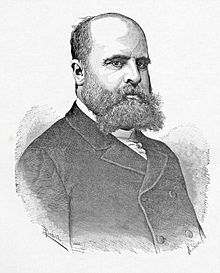Alberto Aguilera
Alberto Aguilera y Velasco (Valencia, August 7, 1842 – Madrid, December 25, 1913) was a Spanish lawyer, journalist and politician, congressman, senator, and Minister of the Interior during the regency of María Cristina de Habsburgo-Lorena and mayor of Madrid on several occasions between 1901 and 1910.
Biography
Early Years
The son of Pablo Aguilera, a judge from Almadén, Ciudad Real, and María Soledad Velasco y Jiménez, a native of Albuñol (Granada), he studied at the University of Madrid, graduating in Law and entering the judicial career at twenty-eight years of age. He held the positions of official of the Treasury Advisory and tax lawyer of the Audiencia de Zaragoza.
Civil Governor
During the reign of Amadeo I and being president of the Council of Ministers, Manuel Ruiz Zorrilla was successively civil governor of Ciudad Real, Oviedo (4-12-1871), Toledo (8-28-1871 to 10-15-1871), Murcia (6-20-1872), Seville (10-12-1872 to 2-19-1873 and again from 7-26-1873). Later, during the Regency of María Cristina, with the governments of Posada Herrera and Sagasta, he was also the Regency of Madrid on several occasions: 10-20-1883 to 1-9-1884; 7-6-1888 to 7-8-1890; 12-13-1892 and 10-6-1897, handling difficult situations before and after the disaster of 1898 with tact and skill.
Deputy and Senator
A member of the Liberal Party, he was elected deputy to Cortes for the Granada district of Albuñol in the successive elections held between 1886 and 1903, although he would renounce this last act of deputy to move to the Senate when he was appointed senator for life on December 23, 1903.
Undersecretary and Minister
He was undersecretary of the Ministry of the Interior from October 17, 1883, with Segismundo Moret, of the Ministry of Finance from August 8, 1886, with Joaquín López Puigcerver.
He held the post of Minister of the Interior between March 12 and November 4, 1894 in a government led by Sagasta.
Madrid City Hall
He was mayor of Madrid between March 7, 1901 and December 10, 1902, between June 15, 1906 and January 28, 1907 and between October 23, 1909 and February 10, 1910.
- 1902. After taking possession of the mayor's office and in order to embellish the villa of Madrid and taking as an excuse the climb to the throne of Alfonso XIII, the inauguration took place on June 5, 1902, of different monuments dedicated to historical characters: the Hero of Cascorro - work of Aniceto Marinas-, Juan Bravo Murillo - work of Miguel Angel Trilles-, Mateo-bra
- 1902. Opening of the Hospital of San Pedro de los Naturales;
- 1904. Approval of the Gran Vía project presented by municipal architects José López Sallaberry and Francisco Andrés Octavio;
- 1906. Impulse for the creation of the West Park;
- 1908. Beginning of the construction of the Maudes Hospital.
Death
He died in his house on Calle de la Magdalena, in Madrid, on December 25, 1913. He was buried in the Almudena Cemetery in Madrid.
Other charges
- General Director of Criminal Establishments (10-12-1885).
- Vice President of the Royal Jurisprudence Academy.
- Member of the Prison Council.
- President of the Circle of Fine Arts.
- President of the Instructive Center of the Worker of Madrid.
Awards
- Big Knight of the Order of Charles III.
- adoptive son of Albuñol.
- A Madrid Avenue has been named since 1903.

